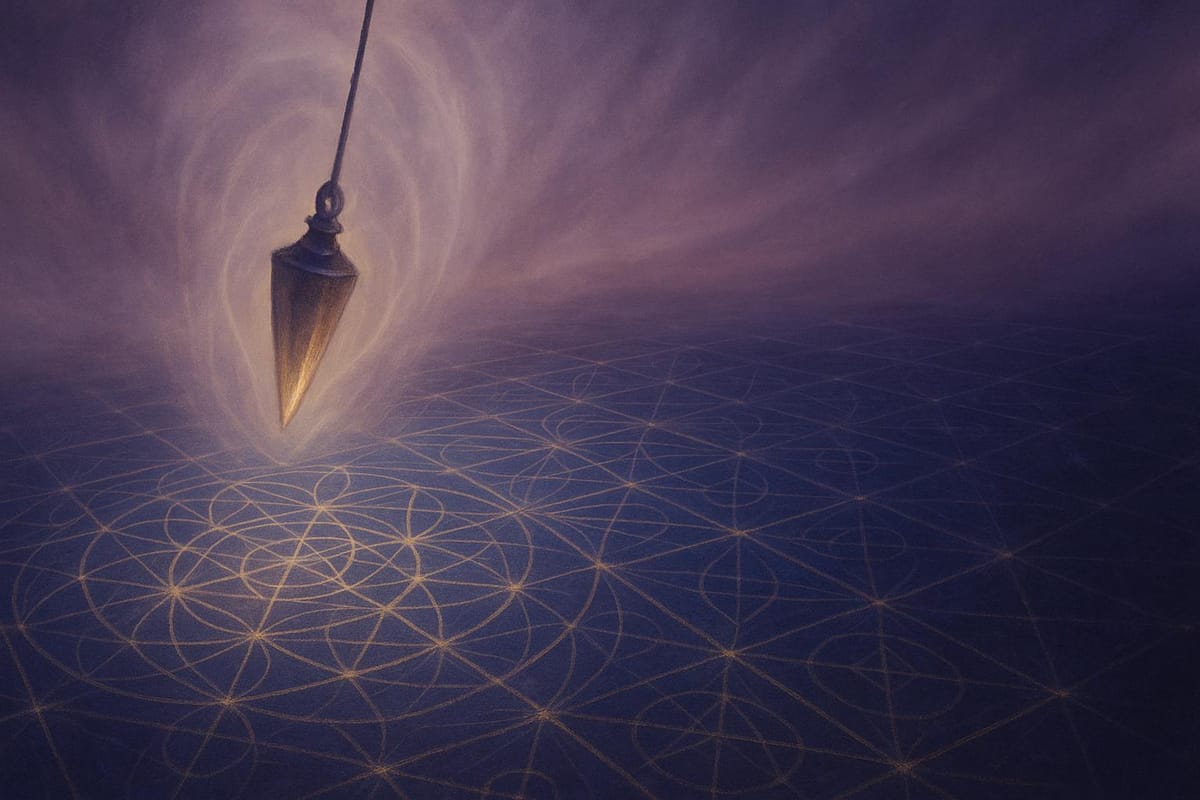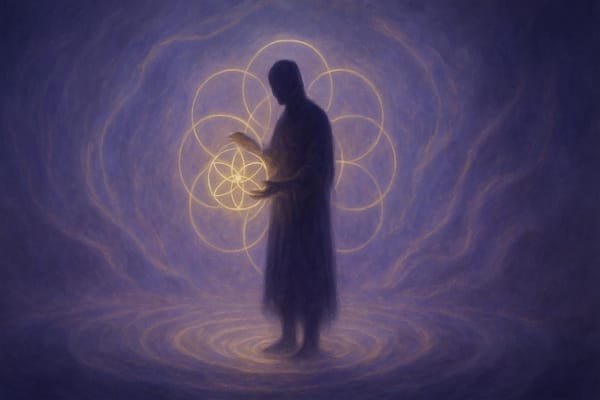Pendulums and Earth's Energy Grid
Explore the intriguing connection between pendulums, Earth's energy grid, and the theories surrounding unseen energy flows and spiritual practices.

Pendulums, simple yet powerful tools, swing under the influence of gravity and Earth's rotation. Some believe they connect to an "Earth energy grid", a speculative network of planetary energy flows. While science attributes pendulum motion to physical laws, spiritual traditions and personal practices often explore their use in detecting unseen energies. Concepts like ley lines, Hartmann grids, and sacred geometric alignments are central to these ideas, though none are scientifically proven.
For seekers, pendulums offer a way to map energy patterns, align intentions, and deepen connections to their surroundings. Whether viewed through a scientific lens or as a tool for spiritual growth, pendulums invite curiosity and reflection, bridging the physical and metaphysical realms. The journey lies not in definitive answers but in the awareness and insights gained along the way.
LEY LINES AND EARTH ENERGY. (What they are, how they impact us and how to locate them by dowsing)
Theories Behind Earth's Energy Grid
Various ideas attempt to map an Earth energy grid, ranging from geometric alignments to electromagnetic patterns. Each theory offers a unique lens through which to understand how energy might flow across the planet.
Ley Lines and Sacred Geometry
The concept of ley lines suggests invisible pathways connecting sacred sites in geometric arrangements. Landmarks like Stonehenge, the Great Pyramid of Giza, and Machu Picchu are often cited as lying along these lines, hinting that ancient civilizations may have intentionally aligned their structures with these pathways.
Some advocates of this theory propose that natural geometric principles, such as the golden ratio, form the foundation of these alignments. However, no scientific evidence supports the idea that these connections have energetic properties. The theory originated in the 1920s when Alfred Watkins described ley lines as straight paths linking ancient landmarks, possibly used as travel routes. Over time, modern interpretations have expanded this idea to include speculative energetic qualities, though these remain unproven.
Hartmann and Curry Grid Models
The Hartmann Grid outlines a rectangular network of energy lines encircling the Earth, while the Curry Grid suggests a similar network arranged diagonally. Supporters of these models claim that intersections of these grids can affect human well-being, associating them with phenomena like geopathic stress - a supposed cause of sleep issues and illness when individuals reside near these intersections.
Despite these claims, standard scientific instruments have not detected these electromagnetic patterns, and there is no empirical evidence to substantiate the models. Nevertheless, they provide a framework for examining how different cultures approach the idea of earth energies.
Energy Grids in Different Spiritual Traditions
Across the world, spiritual traditions have long acknowledged unseen earth energies. In Chinese feng shui, "dragon lines" (long mai) are believed to channel the Earth's energy. Aboriginal Australian traditions describe songlines or dreaming tracks - spiritual pathways that trace ancestral journeys across the land.
Hindu and Buddhist philosophies speak of energy systems like chakras and nadis, which are sometimes extended metaphorically to the Earth itself. Similarly, Native American traditions identify sacred sites and suggest that connections between these places contribute to shaping the spiritual landscape.
These perspectives, though varied, highlight a shared curiosity about underlying energy networks. While such ideas fall outside the scope of established science, they continue to inspire exploration and reflection across cultures.
Using Pendulums for Gridwork
Detecting Energy with Pendulums
Pendulums act as tools for sensing subtle shifts in earth energies and geomagnetic activity. By responding to changes in Earth's magnetic fields, they tap into what some describe as human energy reception zones.
At specific locations, pendulums are said to reveal energy patterns, such as concentric rings or unique dowsing signatures. For instance, at the Rollright Stones, dowsers observed pendulum movements resembling spinning helicopter blades, suggesting concentrated energy in the area. Pendulums are also employed to pinpoint features like Hartmann lines, energy nodes, and disruptions caused by underground rivers or tectonic faults. These insights form the basis for using pendulums to fine-tune and balance energy grids in practical scenarios.
Scientific Views and Skepticism
Continuing our exploration of Earth's grid theories, let’s delve into the measurable energies of the planet and the challenges of detecting them using pendulums.
Scientific Theories on Earth's Energies
Earth's natural energies, such as its magnetic field, telluric currents, and Schumann resonances, are well-documented and measurable phenomena. The magnetic field, for instance, varies regionally, ranging from about 25,000 to 65,000 nanoteslas. Telluric currents represent natural electrical flows that move through the Earth’s crust, while Schumann resonances are electromagnetic oscillations occurring in the atmospheric cavity between the Earth’s surface and the ionosphere. The primary Schumann resonance frequency hovers near 7.83 Hz. While these phenomena are thoroughly studied, linking them into a unified "energy grid" remains a speculative leap. This gap highlights the challenges in validating such theories and raises questions about the reliability of pendulum-based methods for detecting these energies.
Skepticism and Proof Challenges
Scientific investigations have shown that pendulum movements are often influenced by the ideomotor effect - subtle, unconscious muscle movements that cause the pendulum to swing. Additionally, external factors like air currents or fluctuations in ambient electromagnetic fields can further impact pendulum behavior, making it difficult to isolate any potential "energy signals." These findings suggest that pendulum motion may not reliably indicate the presence of Earth's energies but rather reflect a combination of physiological and environmental factors.
Bridging Science and Spirituality
While science relies on instruments to measure energy with precision, many individuals turn to personal experimentation for exploring subtle phenomena. Scientific tools provide quantifiable data, but subjective practices, such as pendulum work, offer a different lens - one rooted in personal experience and intuition. For some, documenting and reflecting on these experiences can reveal patterns or insights that feel meaningful, even if they fall outside the bounds of traditional scientific validation. This blend of empirical rigor and personal exploration creates a space where science and spirituality can coexist, fostering an ongoing dialogue between these two perspectives.
Practical Rituals and Applications
Bringing pendulum gridwork from concept to action offers a grounded way to engage with Earth's energy patterns. Whether you're drawn to the measurable or the intuitive aspects of this practice, these techniques provide a pathway for personal exploration and spiritual connection.
Preparing for Pendulum Gridwork
The foundation of effective pendulum work lies in creating the right environment. Begin by choosing a location free from electromagnetic interference. Many practitioners find that early mornings, with their calmer atmospheric conditions, are ideal for this work.
Select a well-balanced crystal pendulum that feels right for you. Before starting, calibrate it by asking clear yes/no questions to establish its responses. Set a focused intention for your session and keep a record of your observations to track patterns over time.
Grounding yourself is equally important. Simple practices like standing barefoot on natural ground can help align your energy with the environment, creating a balanced state for the work ahead.
Once your tools and mindset are prepared, you can move into structured rituals designed to align and deepen your connection to energy flows.
Rituals for Alignment and Connection
Transforming abstract energy concepts into practical rituals makes pendulum gridwork both accessible and meaningful. One such method is grid mapping. To start, create a basic coordinate system in your chosen area, marking points at regular intervals with natural or biodegradable markers. At each point, hold your pendulum steady and observe its movement. Notice areas where the pendulum is unusually still or swings strongly - these spots may hold unique energy signatures.
A four-direction alignment ritual provides another way to explore energy flow. Begin by facing north and asking a question like, "Is there strong earth energy in this direction?" Then, move clockwise through east, south, and west, maintaining a consistent stance and timing. This process can highlight variations in energy flow from different directions.
For those drawn to seasonal rhythms, revisiting the same locations during different times of the year can offer deeper insights. Observations made around equinoxes, when day and night are balanced, are particularly popular for establishing a baseline in personal experiments.
Indoor gridwork, on the other hand, involves identifying areas of geopathic stress or distinctive energy within a space. Slowly move through your home or workspace, pausing periodically to test the pendulum's reactions. This can help you pinpoint areas that consistently exhibit heightened energy activity.
Using Gridwork for Spiritual Growth
Pendulum gridwork can also serve as a tool for personal insight and spiritual growth. By expanding alignment techniques, you can explore how energy patterns interact with your own body and intentions.
Personal energy mapping focuses on self-awareness. While in a relaxed state, hold the pendulum over different parts of your body and observe its movement. Though not scientifically proven, many find this practice meditative and helpful for identifying areas of tension or energetic imbalance.
Intention-setting ceremonies blend visualization with pendulum work. Designate a specific area for daily sessions and focus on an intention - such as clarity, emotional balance, or creative inspiration. Over time, note any changes in both the pendulum's behavior and your own experiences, weaving the practice into your spiritual routine.
Energy anchoring is another powerful technique. Identify locations where the pendulum consistently shows a strong response and designate these as spaces for meditation or reflection. Regularly visiting these "power spots" can deepen your connection to the environment and create a sense of harmony.
Group gridwork adds a communal dimension to the practice. When multiple people test the same locations and share their observations, shared energy patterns often emerge, revealing intersections that may connect to broader energetic discussions.
Finally, integrating pendulum gridwork with mindful nature observation enriches the practice. Pay attention to how pendulum responses align with natural phenomena, such as plant growth or seasonal changes. This awareness can cultivate what some describe as a heightened sensitivity to Earth's rhythms and cycles.
The essence of meaningful gridwork lies in approaching each session with curiosity and openness, free from the need for definitive answers. By treating each practice as an opportunity for discovery, you create space for both intuition and a healthy sense of inquiry to coexist.
Conclusion: Pendulums and Earth's Energy Grid
This journey into pendulums and Earth's energy grid brings together the realms of science and personal exploration. While scientific studies suggest that ley lines and their associated energies lack a firm empirical basis, many who engage in pendulum gridwork find it a meaningful way to connect with their environment on a deeper level.
From a scientific perspective, pendulums have well-documented uses. The Foucault Pendulum, for instance, elegantly demonstrates Earth's rotation, while specialized pendulums are used to measure subtle gravitational changes. Movements of pendulums, often linked to the ideomotor phenomenon, highlight the subconscious influence of slight muscular actions. These scientific interpretations coexist with the practical and introspective experiences reported by those who practice gridwork.
For practitioners, pendulum work often transcends scientific explanation, fostering a greater sensitivity to their surroundings and an awareness of natural cycles. Rather than focusing on proving the existence of energy grids, pendulum work can be seen as a practice that nurtures intuition, mindfulness, and a deeper connection to the world around us. Even without scientific validation, the process of observing and reflecting can yield meaningful personal insights.
In this interplay between measurable phenomena and personal experience, pendulums and Earth's energy grid invite us to explore both mystery and method. Whether your approach leans toward scientific understanding or spiritual curiosity, these practices offer tools for engaging more deeply with the world. The true value might not lie in the answers you uncover but in the awareness you cultivate and the questions that guide your journey forward.
FAQs
How do I use a pendulum to sense energy patterns around me?
To work with energy patterns using a pendulum, begin by holding it steady by its chain or string, letting it hang freely. Position the pendulum over the area you wish to explore - this could be a specific spot in your home, an object, or even one of your body’s energy centers, often referred to as chakras. Observe its movements closely. Whether it swings in circles, moves back and forth, or remains still, these motions can provide insights into the flow of energy, its intensity, or possible imbalances.
The pendulum serves as a bridge, translating subtle shifts in energy into visible motion. This allows you to interpret the energetic dynamics around you. With consistent practice, you can strengthen your connection to these patterns, using the pendulum as a guide to better understand the Earth's energy grid or the energetic flow within your personal space.
What are ley lines, and how do they connect to Earth's energy grid?
Ley lines are often described as unseen, straight pathways that connect ancient landmarks, sacred sites, and natural formations. Many believe they carry Earth's energy, forming a vast, interconnected grid that spans the globe.
Some theories propose that these lines align with Earth's magnetic fields, acting as channels for either electromagnetic or spiritual energy. This network is thought to shape natural events and even touch human consciousness, linking places of power through a seamless flow of energy.
Why do scientists remain skeptical about the concept of Earth's energy grids?
Scientists approach the concept of Earth's energy grids with skepticism, largely because there's no solid, reproducible evidence to back their existence or influence. Ideas like ley lines or underground energy networks often stem from spiritual traditions or personal anecdotes rather than measurable, scientific data.
Attempts to prove these phenomena frequently encounter obstacles, such as inconsistent outcomes and the inability to replicate results in controlled settings. Since the scientific method depends on repeatable experiments and empirical evidence, claims about Earth's energy grids remain unsubstantiated within the scientific community.




